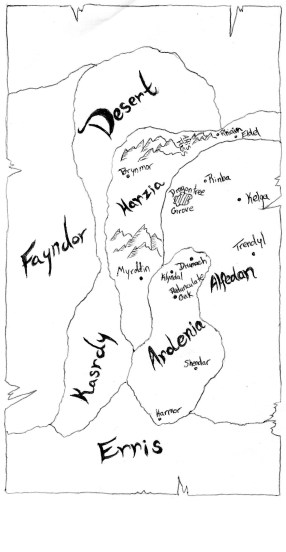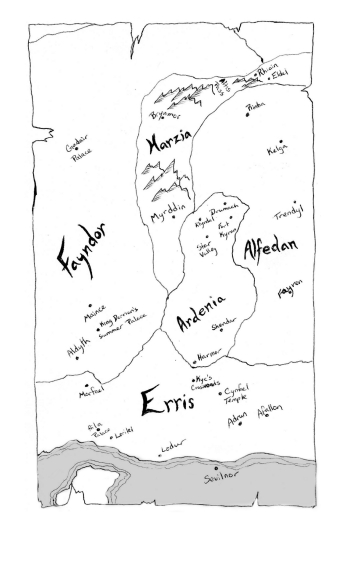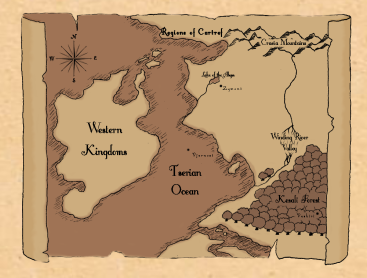I must say that one of the things I love most about writing fantasy is that I get to create maps. I love maps. Always have. Which is ironic, since I’m terrible at geography, but anyway…
It is interesting to see the evolution of my map-making skills over the course of my writing “career.” The very first map I ever made, at least for a book, was the map for The Four Stars when I was about 16.
 This map was done entirely by hand and then scanned into the computer. Thus, the unique font in which the names are written. The first version of this map was drawn in the back of the first notebook I used when writing the story, and I’m pretty sure that I drew it before I even finished writing. Anyone familiar with the books (a limited few, I admit) would notice places on the map that rarely or never appear in the story (namely Myrddin, Brynmor, and the Dragontree Grove). All of these places were intended to be more important than they turned out to be, and when I put this map in the book, I was simply too lazy to take them out. As such, they are there…for decoration…or something like that.
This map was done entirely by hand and then scanned into the computer. Thus, the unique font in which the names are written. The first version of this map was drawn in the back of the first notebook I used when writing the story, and I’m pretty sure that I drew it before I even finished writing. Anyone familiar with the books (a limited few, I admit) would notice places on the map that rarely or never appear in the story (namely Myrddin, Brynmor, and the Dragontree Grove). All of these places were intended to be more important than they turned out to be, and when I put this map in the book, I was simply too lazy to take them out. As such, they are there…for decoration…or something like that.
As time went on, I got a little more creative with some of my maps. The one shown above is from one of my unfinished novels entitled Sentinel. As before, this one was hand drawn on the back cover of the notebook I was writing in, but this time I used some colored pens and added a bit of design to the map itself. I believe that this was the first time I ever used the diagonal lines around the coastlines to indicate water, and frankly I’m not sure where I picked up this habit.
 Some time around or shortly before I went to publish Ancient Vengeance, I discovered a lovely little program called GIMP, which I call “Poor Man’s Photoshop.” It’s a free image editing software that operates much like that lovely $300 program you’re probably familiar with. GIMP gave me a whole new set of tools for creating my maps, including the ability to add solid color into them, making features such as water easier to distinguish.
Some time around or shortly before I went to publish Ancient Vengeance, I discovered a lovely little program called GIMP, which I call “Poor Man’s Photoshop.” It’s a free image editing software that operates much like that lovely $300 program you’re probably familiar with. GIMP gave me a whole new set of tools for creating my maps, including the ability to add solid color into them, making features such as water easier to distinguish.
Recently I have taken another step in my journey to producing maps for my fantasy worlds. My newest work is the first draft of the map for the world my club has collectively created, the world called Cartref. Aside from the basic map outline, everything was assembled in GIMP, from font to compass rose to everything in between. There is a definite benefit to creating maps in GIMP. Most (in fact, all) of the locations listed on the map were named by me, myself, and I, mostly because getting my club members to name things is about like pulling teeth. However, the world we are creating is a common world, so everyone has to agree before we can make something official. Creating a map for a situation like this, if I were to do things the normal way in any case, would have been a pain, as names very likely could change between now and the final draft. In GIMP, however, I can essentially save the project in “limbo.” Every word, every color, every dot has its own layer, so if something needs to be changed, all I need to do is delete that item and be done with it. Very nifty, I must say.
I’ve had a few people comment on my maps over the years, and one or two have even asked me about how to create them, so for those of you who are interested, here are some tips:
#1: Study Other Maps
The majority of my maps were based off of maps I had seen beforehand. My favorite styles are, of course, the classics: Narnia and Middle Earth. But there have been others, too, and each one features ideas for how to handle the various geographical features, everything from towns to mountains to forests and beyond.
#2: Know Your Geography
The truth of the matter is that every really good fantasy writer is as familiar with the real world as he or she is with the world in his or her mind. I’m not saying you have to look at a blank map of the real world and tell me where Bangladesh is. (I certainly couldn’t do it, anyway.) But what you do need to be aware of is how the world works. For instance, you will often find mountains between an ocean and a desert. Why? Mountains block a lot of the moisture that comes up from the ocean, usually leaving the land on the other side dry and parched. Think of the land between the Sierra Nevadas and the Rockies: Nevada, Utah…maybe you could count Arizona. Now, I haven’t been everywhere, granted, but I’ve seen Salt Lake City and Las Vegas. Yeah…they’re a bit lacking in the foliage department. So, when making your map, you might want to consider what the land might look like if you saw it in real life. Not that everyone will care, but it lends credibility to your world.
#3: Make it Real
It doesn’t matter how pretty the coastline, you will never see a continent or island with a perimeter that is 100% smooth. It’s the thing I love most about nature. If you can’t draw a straight line, that’s ok. You don’t see very many straight lines in nature anyway. In map-making, jagged edges are a plus. The way I do that is that I simply tighten the muscles in my hand and slightly move my hand back and forth as I draw. That may be easier said than done, but the idea is to make the lines slightly jagged. It makes for a much more realistic map.
#4: The Computer is Your Friend
If you’re not friends (or frenemies, as the case may be) with your computer by now, you might want to work on that relationship. I have found GIMP to be indispensable when it comes to map-making, but there are other programs that work just as well. Photoshop should probably work just as good or better, but it has more functions and can tend to be a little more confusing than GIMP. Well, it’s more confusing to me, anyway, but that’s not saying much…
#5: Have Fun!
You can always carry around a list of dos and don’ts regardless of whether you’re creating maps or writing the next Great American Novel, but there really is no point to it all unless you’re having fun doing it. Map-making doesn’t have to be a chore. Though I spend hours on mine, it’s just as easy to create simple maps, too. It all depends on how much you put into it.



Good start on the map. I guess the first question I have is where the various races are. I can figure out the Crae from the mountains. But there are cities listed there, and we should probably agree who is in what city.
You’ve done some good work here, and I look forward to start the fleshing out of Cartref with our first few stories.
OK, I went to the project page, and you explained about the cities. My bad. .